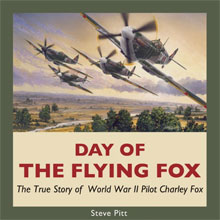| ________________
CM . . .
. Volume XV Number 6. . . .November 7, 2008 
 |
Day of the Flying Fox: The True Story of World War II Pilot Charley Fox.
Steve Pitt.
Toronto, ON: Sandcastle/Dundurn, 2008.
138 pp., pbk., $19.99.
ISBN 978-1-55002-808-9.
Subject Headings:
Fox, Charley, 1920-
World War, 1939-1945-Personal narratives, Canadian.
World War, 1939-1945-Aerial operations, Canadian.
Air pilots-Canada-Biography.
Rommel, Erwin, 1891-1944.
Grades 9 and up / Ages 14 and up.
Review by Val Ken Lem.
*** /4
|
| |
|

excerpt:
The Fleet Finch was designed to be an easy-to-fly airplane, and Charley mastered the feel of the controls quickly as he learned to make coordinated rudder/joystick turns and other simple manouevres. Novice British Commonwealth Air Training Pilots (BCATP) pilots started off by flying "bumps and circuits" as a solo test. The "bumps" were practice takeoffs and landings made in the course of doing a circuit around the airfield. Pilots were supposed to take off into the wind, climb to an appropriate altitude, turn, then fly rectangles until they were able to come back down. They were expected to make their descents into the wind but just touch their planes' wheels to the runway long enough to confirm good landings, then take off again and repeat the procedure until waved in by an instructor.
Day of the Flying Fox is much more than simply a biography of one Canadian fighter pilot: it is an account of the Canadian aerial operations during the Second World War. Charley Fox's personal story is central to the work, but his story is often used to lead into a more general tale of what life was like in the air force for recruits in Canada experiencing basic training and then specialized flight training followed by posting to air bases in Britain and, later on, Allied-controlled soil in continental Europe. The book includes numerous sidebars containing "fascinating facts" that provide informative insight into topics as diverse as the origins of the RCAF's distinctive blue uniforms, the history of the Link flight simulator, historical and technical details about the variety of aircraft used for training and combat, and the names and accepted record of "kills" of top flying aces from both WWI and WWII. Additional sidebars are devoted to "wordplay" wherein terms such as variable pitch propeller, or cockpits and dogfights are explained in etymological detail. Together, the interesting narrative and fact-filled sidebars make for a very informative work.
The first chapter contains a great deal of background information about the origin of the war, and subsequent chapters include a considerable amount of detail about the course of the war, including specific operations, such as the failed raid on Dieppe in 1942 and the lessons it provided the Allies when preparing for the June 1944 invasion of Normandy. This information helps to set Fox's story in context and makes for a richer work that will appeal to students of the war and not just those interested in the aerial operations or the biographical aspects of the work.
Anecdotes, such as Fox's conclusion that, once his older brother Ted enlisted in the Canadian army, he would have to enlist in another branch of the Canadian military because the army wouldn't be big enough for the two Fox brothers brings out a unique side to the personal story. Fox excelled in pilot training and subsequently was assigned a position as a flight instructor in the second half of 1941. This allowed him to hone his skills and to get married in 1942. The following year, his request to join the ranks of the fighter pilots serving in the European arena was granted.
Fox received the Distinguished Flying Cross for his bravery and leadership in combat, and later received a Bar to the Cross, meaning that he was awarded the medal twice. Many of the targets of his attacks were enemy land vehicles, including locomotives. He is also credited with destroying four enemy aircraft, but historical research suggests that he was responsible for the downing of a fifth plane. Researchers also conclude that Fox was responsible for strafing the Nazi staff car carrying German Field Marshall Rommel on July 17, 1944. Following the war, Fox returned to civilian life but later rejoined the RCAF in 1954 and became a pilot and flying instructor in a reserve unit.
Two dozen archival photographs of aircraft mentioned in the text, as well as photos of Fox and other pilots and related war images, provide appropriate visual content. There is no index, but Pitt does include a useful list for further reading and a list of selected websites. Most of the sites are associated with aviation museums in Canada. The quality of the content and usability of the sites sampled vary as one would expect. The webliography would be stronger if Pitt had omitted sites like one that seems primarily geared to selling a publication and focused on the best of the best.
Recommended.
Val Ken Lem is a member of the Collection Services Team of the Ryerson University Library in Toronto, ON.

To comment
on this title or this review, send mail to cm@umanitoba.ca.
Copyright © the Manitoba Library Association. Reproduction for personal
use is permitted only if this copyright notice is maintained. Any
other reproduction is prohibited without permission.
NEXT REVIEW |
TABLE OF CONTENTS FOR THIS ISSUE
- November 7, 2008.
AUTHORS |
TITLES |
MEDIA REVIEWS |
PROFILES |
BACK ISSUES |
SEARCH |
CMARCHIVE |
HOME |
